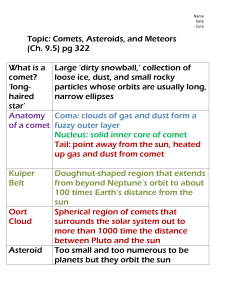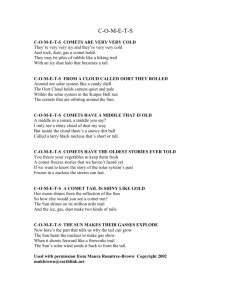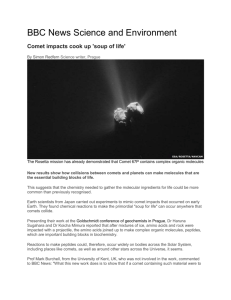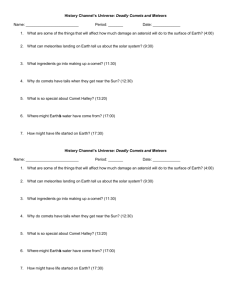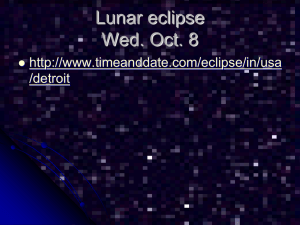Star and Planet Formation
advertisement
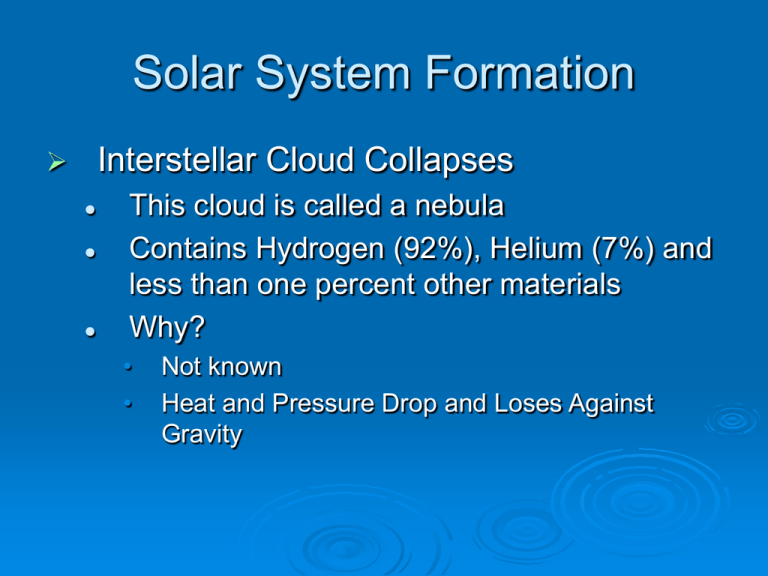
Solar System Formation Interstellar Cloud Collapses This cloud is called a nebula Contains Hydrogen (92%), Helium (7%) and less than one percent other materials Why? • • Not known Heat and Pressure Drop and Loses Against Gravity Solar System Formation Center of Mass Forms a Star, Additional Mass is attracted towards the center and form a nebula Rotational Speed of the Cloud Increases Think Figure Skater Star and Planet Formation The Spinning Nebula Flattens in a Disk Think Pizza Dough Planets Form from the Disk of Gas and Dust Planetesimals • Small irregular shape bodies Formation of Planets Inner Outer High Temps Cold Temps Only Metals (Fe and Ices of Ammonia, Silicates) Solidified Methane, Carbon Dioxide and Water Small, because of the where able to solidify sun’s gravitational pull Became large enough to capture the remaining He and Hydrogen Orion Nebula Eagle Nebula Lagoon Nebula Horse Head Nebula Asteroids Large Rocks Orbiting the Sun Most are Found in the Asteroid Belt Between Mars and Jupiter Why do we have a Asteroid Belt? Most Scientist Believe that the Asteroid Belt is made up of remnants of a planet that would of formed had it not been for Jupiter Solar System Debris Meteors and Asteroids Meteor: Bright Streak of Lights in the Sky Meteoroid: the Particles that Bring About the Light Meteorites: Are the Remnants of a Meteoroid found on Earth Properties and Stats Frequency 3 300 tons of Extraterrestrial Rock and Dust Fall on Earth Each Day Usually you Can See a Meteor once Every Several Minutes on any Given Night Types Stony 94% Irons 5% Stony Irons 1% Comets Dirty Snowballs 1-10 km in Diameter Orbit the Sun, Produce a “Tail” When they get within 3 AU of the Sun Tail Points Away from the Sun Two Types of Comets Short Period (Orbital Period < 200yrs) Long Period (Orbital Period > 200yrs) Anatomy of a Comet Typical Comet Orbit Comet Hale Bopp 1997 Comet Hale Bopp Comets Stats Eccentricity Orbital Period 0.995 2537 Years Next Visit 4380 Haley’s Comet 1986 Comets Stats Eccentricity 0.967 Period 76 Years 2061 Comets Oort Cloud 100,000 AU from the Solar System Long Period Comets Orbital Periods Greater than a Million Years Oort Cloud Comets Kupier Belt 30-500 AU 35,000 objects with Diameters Greater than 100km Short Period Comets Originate From Here Haley’s Comet Kupier Belt Fate of Comets Each Time a Comet Passes about 1% of the nucleus is burned off Dust Particles Break Off, if Earth’s Orbit intersects comets orbit, We Experience Meteor Showers If Pass Very Shortly After the Comet Passes, We Experience a Meteor Storm Famous Meteor Showers Shower Dates Comet Lyrids April 20 -23 Comet 1861 I Eta May 3 – 5 Halley’s Perseids Aug. 12 Comet 1862 III Orionids Oct 20 Halley’s Comet Taurids Nov. 3 – 13 Comet Encke Leonids Nov. 18 Comet 1866 I Shoemaker Levy 9 Jul/Aug 94 SL9 Cont’d Meteor Shower
